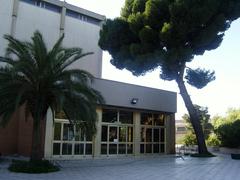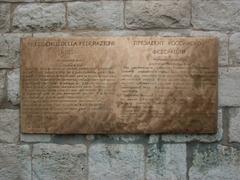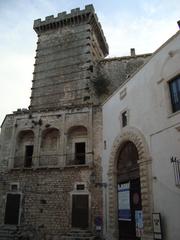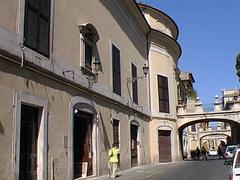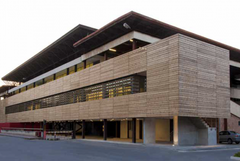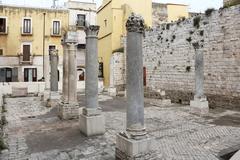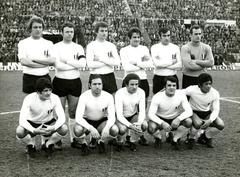
San Nicola Bari Visiting Hours, Tickets, and Historical Sites Guide
Date: 04/07/2025
Introduction to San Nicola Bari: What Visitors Should Know
The Basilica di San Nicola in Bari, Italy, stands as a monumental testament to faith, history, and cultural synthesis. Renowned for safeguarding the relics of Saint Nicholas—a figure whose generosity inspired worldwide traditions, including Santa Claus—the basilica is both a religious sanctuary and a beacon of architectural grandeur. Its origins trace to the late 11th century, when sailors from Bari famously brought Saint Nicholas’s relics from Myra (in modern-day Turkey), a feat that elevated Bari’s spiritual stature and catalyzed the construction of this Apulian Romanesque masterpiece. Today, the basilica welcomes both pilgrims and tourists, offering immersive experiences: from its fortress-like façade and atmospheric crypt to its role as a vibrant cultural hub hosting events like the Festa di San Nicola each May. Beyond the basilica, visitors can explore the charming Bari Vecchia neighborhood and notable landmarks such as the Castello Normanno-Svevo and Bari Cathedral (Summer in Italy; Visit Puglia; Italien Expert).
This comprehensive guide covers the basilica’s history, significance, visitor information (including San Nicola Bari visiting hours, ticketing details, accessibility, and guided tours), and practical tips for making the most of your visit. Whether you seek spiritual solace, architectural beauty, or cultural enrichment, you’ll find all the essentials for a memorable experience at one of southern Italy’s most treasured landmarks.
Contents Overview
- Introduction
- Origins of San Nicola and the Arrival of the Relics
- Construction and Architectural Significance
- Visiting the Basilica di San Nicola: Hours, Tickets, and Accessibility
- Religious and Cultural Significance
- Rivalry, Civic Identity, and Local Traditions
- Influence on Global Traditions and Ecumenical Importance
- The Basilica in Bari’s Historical and Cultural Context
- Artistic and Cultural Heritage
- Practical Tips for Visitors
- Festa di San Nicola in Bari 2025: Visiting Hours, Tickets, and Complete Guide
- Visiting the Basilica di San Nicola: Hours, Tickets, and Bari Historical Sites Guide
- FAQ
- Conclusion
Basilica di San Nicola in Bari: History, Visiting Hours, Tickets, and Must-See Attractions
Origins of San Nicola and the Arrival of the Relics
The basilica owes its existence to Saint Nicholas’s relics, brought to Bari from Myra in 1087 by local sailors. Saint Nicholas, a 3rd-century bishop celebrated for his generosity and miracles, became a major pilgrimage figure after his death in 343 AD (Summer in Italy). The transfer of his relics not only elevated Bari’s religious status but also inspired the creation of the basilica.
Construction and Architectural Significance
Construction began in 1087 under Italo-Norman rule and concluded in 1197, specifically to enshrine the saint’s relics (Wikipedia). The basilica is an Apulian Romanesque masterpiece, with a solid limestone façade, soaring arches, a gilded ceiling, and a crypt with marble columns where the relics are venerated (Summer in Italy).
Visiting the Basilica di San Nicola: Hours, Tickets, and Accessibility
- Opening Hours: Typically 7:30 AM–12:30 PM and 4:30 PM–7:00 PM. Hours may vary during holidays and special events.
- Admission: Free entry; donations appreciated. Guided tours available for a fee.
- Accessibility: Ramps and assistance for visitors with reduced mobility.
- Location: In Bari Vecchia, accessible by public transport and close to other historic sites.
Religious and Cultural Significance
Saint Nicholas is Bari’s patron saint, revered for his miracles and generosity. The basilica serves as a spiritual crossroads for Catholic and Orthodox pilgrims (Wikipedia). Major celebrations include processions and the unique tradition of parading the saint’s statue onto the sea during festivities in December and May (Italy Heritage; Puglia Paradise).
A key event is the collection of the “Manna” of Saint Nicholas, believed to have miraculous properties, celebrated each May 9th (Italy Heritage).
Rivalry, Civic Identity, and Local Traditions
Saint Nicholas’s arrival led to a local rivalry with San Sabino, ultimately resolved by naming Nicholas as Bari’s primary patron. The city’s proverb—“Sande Necóle jè amánde de le frastìre” (“Saint Nicholas loves foreigners”)—reflects Bari’s welcoming spirit (Italy Heritage).
Influence on Global Traditions and Ecumenical Importance
The cult of Saint Nicholas inspired the Santa Claus legend and spread across Europe (Summer in Italy). The basilica is a symbol of unity between Eastern Orthodox and Western Catholic Christians, hosting delegations and pilgrims from around the world (Wikipedia).
The Basilica in Bari’s Historical and Cultural Context
Bari, a historic trade hub, has been shaped by Roman, Byzantine, and Norman influences. The basilica’s location near the seafront in Bari Vecchia underscores its role as a gateway between East and West (The Thinking Traveller). Nearby attractions include Castello Svevo and Bari Cathedral.
Artistic and Cultural Heritage
The basilica houses gifts from popes and rulers, medieval frescoes, and mosaics depicting Saint Nicholas’s life (Moments Log). It remains a center for faith, art, and cultural events.
Practical Tips for Visitors
- Best time to visit: Early morning or late afternoon.
- Tickets: Entrance is free; guided tour fees vary.
- Photography: Allowed, but check restrictions.
- Nearby attractions: Castello Svevo, Bari Cathedral, Bari Vecchia.
- Transportation: Easily accessible from Bari Centrale station by bus or taxi.
Visiting San Nicola Basilica in Bari: Hours, Tickets, and Cultural Significance
Religious and Cultural Significance
The Relics of Saint Nicholas: A Pillar of Christian Pilgrimage
In 1087, Bari sailors brought Saint Nicholas’s relics from Myra, transforming Bari into a major pilgrimage destination (visit.puglia.it; touristplaces.guide). Saint Nicholas, patron saint of sailors, children, and students, inspired the modern Santa Claus (nomads-travel-guide.com). The basilica fosters unity between Roman Catholic and Orthodox communities (tiqets.com).
The Basilica as a Symbol of East-West Christian Unity
The crypt is a revered pilgrimage site for Catholics and Orthodox Christians. The Centro Ecumenico encourages joint celebrations, especially during feast days (basilicasannicola.it; visit.puglia.it).
Major Religious Festivals and Rituals
- May Feast (May 7-9): Features processions, maritime parades, and the display of the “Holy Manna” (bariexperience.com).
- December 6 (Saint Nicholas Day): Celebrated with masses and processions (bariexperience.com).
Artistic and Architectural Heritage
The basilica’s Romanesque design includes a fortress-like façade, Byzantine columns, and a marble crypt (nomads-travel-guide.com). The sacristy contains valuable gifts from popes and rulers (touristplaces.guide).
The Nicolaian Museum
Next to the basilica, this museum displays liturgical objects, icons, and manuscripts celebrating Saint Nicholas’s veneration (visit.puglia.it).
Local Traditions and Community Identity
Festivals feature processions, music, and local foods like orecchiette pasta, made by women in Bari Vecchia (winalist.com). The basilica also hosts concerts and art events (visit.puglia.it).
Global Influence
Saint Nicholas’s cult influences Christian traditions globally, inspiring customs like Santa Claus (touristplaces.guide; tiqets.com).
Visitor Information: San Nicola Bari Visiting Hours, Tickets, and Tips
- Visiting Hours: Usually 7:00 AM–12:00 PM and 4:30 PM–7:30 PM. Check the official website for updates.
- Admission: Free. Guided tours and museum entry require tickets (tiqets.com).
- Accessibility: Fully wheelchair accessible.
- Guided Tours: Available in several languages; book in advance during feast days.
- Nearby Attractions: Bari Vecchia, Norman-Swabian Castle, seafront promenade.
- Photo Tips: The façade, crypt, and festival processions are highlights.
Festa di San Nicola in Bari 2025: Visiting Hours, Tickets, and Complete Guide
Historical Origins and Evolution
The festival traces back to 1087, when Bari sailors retrieved Saint Nicholas’s relics from Myra. This act boosted Bari’s religious status and economy (Region Puglia; Drintle). The basilica was consecrated in 1089 (Italyscapes). The festival has evolved into a major religious and cultural event, with the 2025 edition marking the 938th anniversary (Drintle).
Religious and Cultural Significance
Saint Nicholas is venerated as Bari’s patron and as a unifying figure for Catholics and Orthodox Christians. The basilica features ecumenical chapels and hosts prayers and gatherings for Christian leaders (Region Puglia; Puglia Guys). His legacy includes legends of secret gift-giving, inspiring Santa Claus (Region Puglia).
Key Events and Program Highlights
Pre-Festival (April)
- April 20: Mass commemorating the relics’ departure from Myra.
- April 27: Public display of Saint Nicholas’s statue.
May 7: Historical Reenactment
A dramatic procession reenacts the relics’ arrival, winding through Bari Vecchia (Italyscapes).
May 8: Sea Procession and Mass
A sunrise Mass is followed by a sea procession, with the saint’s statue paraded along the coast (Camin Vattin).
May 9: Anniversary of the Translation
Features the extraction of the “manna” from the saint’s tomb, believed to be miraculous (Puglia Guys).
Additional Festivities
Bari’s center hosts markets, food stalls, music, fireworks, and performances. Traditional foods include panzerotti, sgagliozze, popizze, and focaccia (Region Puglia).
Tickets and Visiting Hours
- Basilica Hours: 7:00 AM–8:30 PM, with variations during events (Italien Expert).
- Admission: Free (Budget Your Trip).
- Guided Tours: Available in multiple languages; tickets can be purchased online or at tourist offices (Italien Expert).
- Special Events: Most are free; some require advance booking.
Practical Information
- Location: Largo Abate Elia, Bari Vecchia. Many streets are pedestrianized during the festival (Italien Expert).
- Transport: Use public transit or shuttle buses from park-and-ride lots (Region Puglia).
- Dress Code: Modest attire required.
- Photography: Allowed without flash; not permitted in the crypt during services (Italien Expert).
- Safety: Crowds are large; be vigilant (Wolters World).
Visiting the Basilica di San Nicola: Hours, Tickets, and Bari Historical Sites Guide
Historical Background
The basilica, built in the 11th–12th centuries to house Saint Nicholas’s relics, is a key religious structure in southern Italy. Its foundation stone was laid by Abbot Elias, and it was consecrated in 1197. The basilica survived the 1156 destruction of Bari, highlighting its significance (TravelTriangle; Savoring Italy; Passaporte No Bolso).
Architectural Features
The basilica exemplifies Apulian Romanesque style, with a pale limestone façade, a nave flanked by aisles, a gilded ceiling, and a crypt housing the saint’s relics. The altar area boasts intricate mosaics and a 12th-century ciborium (TravelTriangle).
Religious and Cultural Significance
Saint Nicholas is the patron of children, sailors, and Bari itself, as well as Russia. The basilica is especially significant for Russian Orthodox pilgrims, particularly during the May feast (Savoring Italy). A unique tradition involves single women leaving prayers at the saint’s tomb (Passaporte No Bolso).
Location and Access
The basilica’s address is Largo Abate Elia, 13, Bari Vecchia. It’s within walking distance of other historical sites, such as the Cathedral of San Sabino and Castello Normanno-Svevo (Savoring Italy).
Visiting Hours and Admission
- Hours: 7:00 AM–8:30 PM (check the official website for updates).
- Admission: Free; donations welcome. The crypt may be closed during Mass.
Guided Tours and Accessibility
Tours are available in multiple languages and can be booked on-site or through local operators. The basilica is wheelchair accessible.
Dress Code and Etiquette
Visitors should dress modestly and maintain silence, especially in the crypt and during services. Photography is generally allowed without flash or tripods.
Special Events and Festivals
The Festa di San Nicola (May 7–9) is the highlight of the year, featuring processions, fireworks, and traditional performances (TravelTriangle).
Safety and Surroundings
Bari is safe, but visitors should be mindful of pickpockets during crowded events. Certain neighborhoods are best avoided (TravelTriangle).
Nearby Historical Sites
Combine your visit with the Cathedral of San Sabino, Castello Normanno-Svevo, and the vibrant streets of Bari Vecchia. Enjoy local cuisine like focaccia and orecchiette (Savoring Italy; Passaporte No Bolso).
Tips for a Memorable Visit
- Best Time: May (for the festival), early mornings or late afternoons for quiet visits.
- Language: Italian predominates, but English and Russian are also spoken.
- Souvenirs: Purchase religious items and local crafts at the basilica shop.
- Cuisine: Sample regional specialties in nearby trattorias (Savoring Italy).
Frequently Asked Questions (FAQ)
Q: What are the Basilica di San Nicola visiting hours?
A: Typically 7:00 AM–8:30 PM, but hours may vary during religious events.
Q: Is there an entrance fee?
A: No, entry is free; donations are welcome.
Q: Is the basilica wheelchair accessible?
A: Yes, with ramps and elevators for visitors with mobility challenges.
Q: Can I take photos inside?
A: Photography is generally allowed, but avoid flash and tripods.
Q: Are guided tours available?
A: Yes, in multiple languages—book on-site or via local operators.
Visuals and Interactive Media Recommendations
- Include high-quality images of the basilica’s façade, interior, crypt, and festival celebrations.
- Use alt tags such as “San Nicola Bari visiting hours” and “Bari historical sites” for SEO.
- Interactive maps and virtual tours are available on official tourism websites.
Internal Links for Further Exploration
Conclusion and Final Visitor Tips
Visiting the Basilica di San Nicola in Bari is a journey through centuries of religious devotion, architectural achievement, and cultural tradition. The basilica’s Apulian Romanesque architecture and sacred relics create an atmosphere that resonates with visitors and pilgrims alike. Festival times, especially in May and December, offer a vibrant display of Bari’s local culture and maritime heritage.
For a fulfilling experience, plan ahead with knowledge of visiting hours, ticketing, and accessibility, and take time to explore the surrounding Bari Vecchia district. Engaging in local traditions during festival periods provides a deeper connection to the city’s living legacy.
Utilize guided tours and interactive resources to enhance your understanding. Stay updated through official channels and travel apps like Audiala for news on special events and practical tips.
In sum, the Basilica di San Nicola is both a spiritual pilgrimage site and a cultural treasure, inviting you to explore Bari’s rich heritage and the broader Christian tradition. Make the most of your visit by embracing the unique atmosphere of this iconic Italian landmark (Basilica di San Nicola Official Site; Region Puglia; TravelTriangle).
Sources and Further Reading
- Basilica di San Nicola in Bari: History, Visiting Hours, Tickets, and Must-See Attractions, 2025, Summer in Italy (https://www.summerinitaly.com/guide/basilica-of-st-nicola)
- Visiting San Nicola Basilica in Bari: Hours, Tickets, and Cultural Significance, 2025, Visit Puglia (https://visit.puglia.it/en/bari)
- Festa di San Nicola in Bari 2025: Visiting Hours, Tickets, and Complete Guide to Bari’s Historic Festival, 2025, Region Puglia (https://www.regionepuglia.org/festa-san-nicola-bari/)
- Visiting the Basilica di San Nicola: Hours, Tickets, and Bari Historical Sites Guide, 2025, TravelTriangle (https://traveltriangle.com/blog/bari-in-january/)
- Basilica of Saint Nicholas, Bari - Wikipedia (https://en.wikipedia.org/wiki/Basilica_of_Saint_Nicholas,_Bari)
- Festa di San Nicola 2025, Drintle (https://drintle.com/festa-di-san-nicola-2025-bari-puglia-eventi-programma-riti/)
- Italen Expert - Basilica di San Nicola in Bari (https://italien.expert/en/the-basilica-di-san-nicola-in-bari-apulia/)
- Passaporte No Bolso - Things to Do in Bari (https://passaportenobolso.com/en/things-to-do-in-bari/)
- Tourist Places Guide - Top 10 Must Visit Tourist Places in Bari (https://touristplaces.guide/top-10-must-visit-tourist-places-in-bari/)
- Puglia Paradise - Festivals and Events in Puglia from May to August 2025 (https://pugliaparadise.com/festivals-and-events-in-puglia-from-may-to-august-2025/)
- Italy Heritage - Traditions Calendar (https://www.italyheritage.com/traditions/calendar/december/san-nicola-di-bari.htm)

